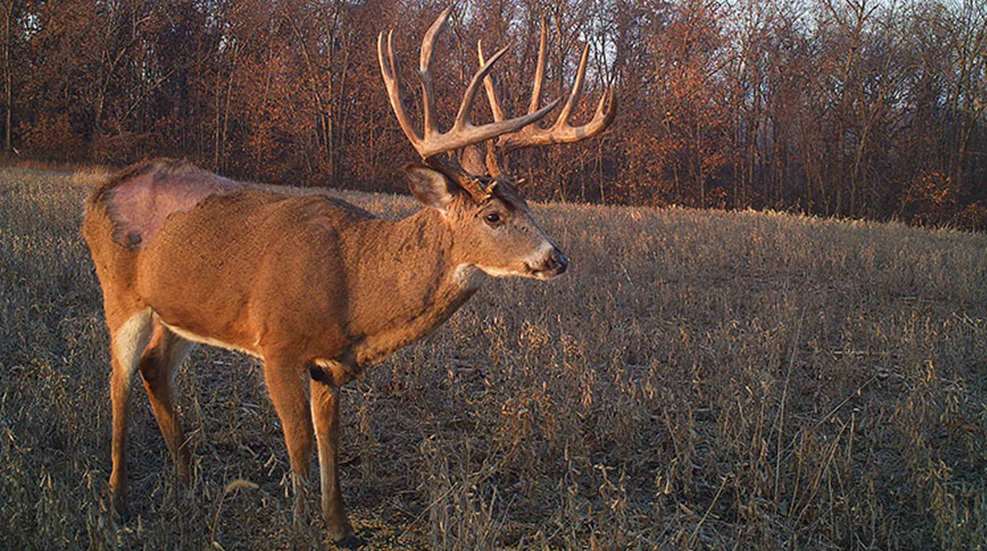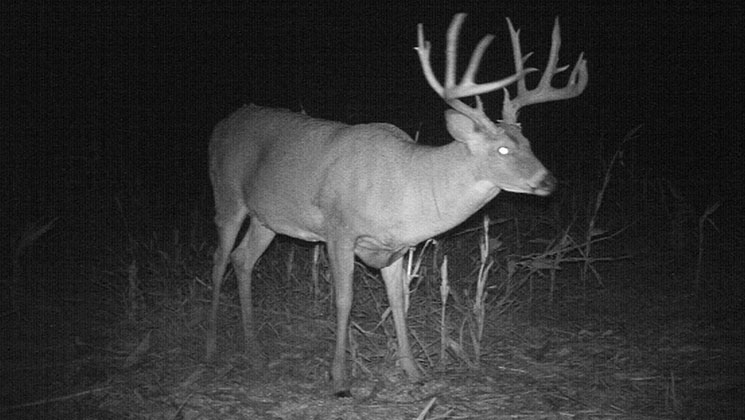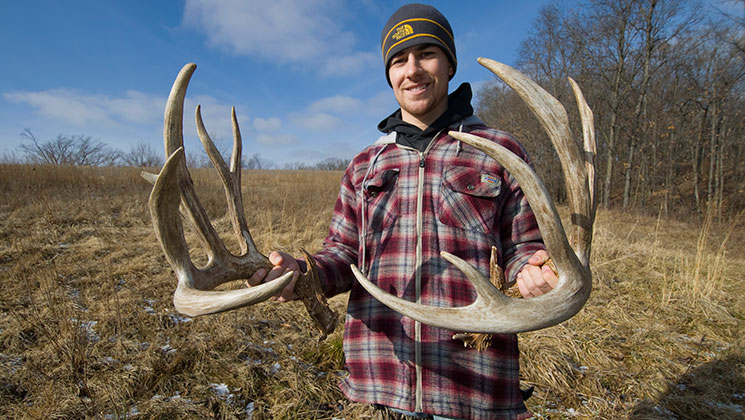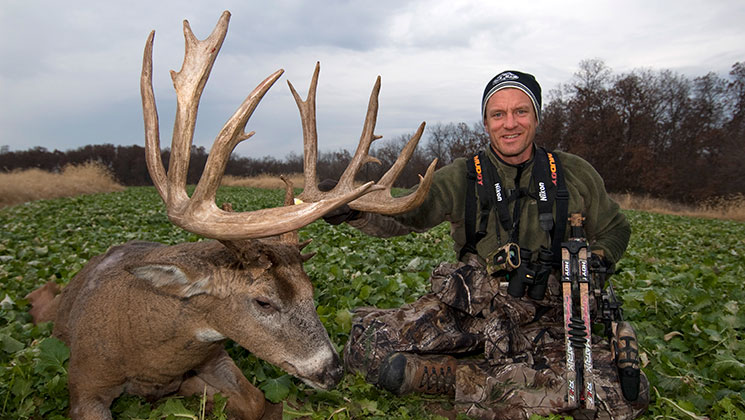
The early events of my hunt for a buck I named the “Double G4 Buck” were full of miscues. In fact, that deer became my poster child for anxiety. I messed up enough to give myself ulcers, but in the end I got him. Here is how the buck’s behavior changed over the years I hunted him and how I adjusted my hunting strategies to finally shoot the biggest buck of my life.
Year Zero
I became aware of this buck in 2008 but I didn’t start hunting him then. He had two G4s on each side and was a nice looking young buck. I had him at less than 40 yards one evening but elected not to shoot. His potential was obvious. I saw him twice that season, both times in about a 100-acre area. I forgot about the Double G4 Buck until I found one of his sheds a few months later in late January. He’d made it through the season so I hoped he would grow into something special.
Year One
With the potential he showed the year before as a 3-year-old, the Double G4 Buck certainly would look good in 2009. That was an understatement. The first time I saw him I nearly fell from my stand—and I almost didn’t recognize him. He looked good, all right!
November 5 was one of those magical frosty clear rut mornings made even more exciting by a hot doe that came through the area. It was the kind of morning we dream about all year. Bucks showed up from everywhere. Before the action was over, I had seen every mature buck within a half-mile and one of them lay on the ground. Though the feeling may be short-lived, days like that can make you think you are a genius at selecting stands.
By 10 a.m., I had seen three big shooter bucks, one a giant 10-point that I figured would score close to 170 inches. Unfortunately, he disappeared on his way in to investigate my grunt call. I have no idea where he went, but when a different dandy buck came in from the other direction minutes later, I couldn’t pass up the shot.
It wasn’t until later when we were studying the hunt video that we realized the giant 10-point that disappeared was the same buck that had the double set of G4s the year before. He had the same short brows and a characteristic sag in the skin under his brisket. We knew it was him. Plus it was the same area (same stand) where I had seen him the previous year.
I still had another tag—my landowner’s tag—so I spent every day for the rest of the season hunting the Double G4 Buck. Though I logged hundreds of hours in some tough conditions, especially during the late season, I only saw him two more times. The sightings were spread out, one more than a half-mile from where I had seen him in November. His range seemed to be about 400 acres, possibly more. That is a lot of ground to cover and makes for a lot of places to hide, which he did very effectively. As a 4-year-old, Double G4 was turning into a ghost. I got a few late-season photos of him on the trail cameras but never found either shed that winter.

Year Two
This is going to be a short section but it encompasses a long stretch of hunting time. I hunted the buck relentlessly in 2010 but never saw him once. He was 5 years old that year. I tried to hunt smart, but I was there hunting him every single day. Maybe he sensed the pressure, but I don’t think so. I believe he dropped off the radar because he was nocturnal. I got a few nighttime photos of him in a food plot in the center of what I guessed was his core area—the same ridge where I saw him the previous two years. He wasn’t leaving that area, but he was like a ghost within it.
Though I didn’t blanket the area, I did have a few other cameras within 300 yards of the ridge. He didn’t show up on any of them and though I felt like I was wasting time, I couldn’t stop hunting him. From those few photos, I realized that his antlers had grown even larger. Now he was pushing 180 inches.
I am guessing I hunted that buck for 60 to 70 days in 2010 without a single sighting. Seasons like that can wear on your patience and resolve. I vowed that I wouldn’t hunt the buck that hard again unless he showed up at least a few times on my trail cameras during daylight.
As a 5-year-old he was a ghost, as many of them are. Some expert hunters call this their “ghost year.” I would have to agree based on what I learned from this buck, and a few others since.
Year Three
The world turned upside down when the Double G4 Buck reached 6 years old. I think that may be the biggest lesson I learned from hunting this deer—how much his personality changed each year. He went from being a ghost, the most invisible deer on our farm in 2010, to being one of the most visible and most easily patterned deer just one year later. It was amazing, and it restored my hope as a deer hunter. Those old bucks can change and become killable as they get older. They don’t necessarily become harder to hunt or get “smarter” every year.
The party started in early August when one of my video editors filmed the buck coming out on a soybean field. The field bordered the same area where I had seen the buck and gotten trail-camera photos of him in the past, but now he was coming out in broad daylight. What a sight! He was stunning—now a giant 11-point with sweeping 200-inch-plus antlers. It made my stomach churn and twist in knots just thinking about what might happen if he came past one of my treestands. On top of that, I started to get trail-camera photos of him nearby in mid-September. The best part: They were daylight photos. I played it down, but I was getting butterflies in my stomach. I could feel the tide had changed. Double G4 was no longer nocturnal. This was going to be an interesting season.
I kept running trail cameras in various parts of his known range and got occasional daylight photos of him right up to the time I started hunting him. That is when I pulled the cameras and focused on strategy. For better or worse, I don’t like to run cameras during the time I am hunting. I like using the information I gained going into the hunt and then piecing things together from there.
My first encounter with the Double G4 Buck came on Nov. 9. I had him dead to rights. My adrenaline was pumping and my heart was racing as he made his slow way toward the stand, trailing an obviously hot doe. I tried to gain control, but it was tough. Once again, luck favored the buck. The doe was 20 yards out and he was 20 yards behind her, in thick cover, when another mature buck showed up and fought him for the doe. “My” buck lost and the other deer ran him off right before my eyes. As the pair was battling and chasing, the doe walked right past the stand at 5 yards. Oh, what could have been!
Ten minutes later, the winner came back to claim the prize and pig-grunted with every step as he tore up the ridge top with his antlers looking for her. I couldn’t pass him up. Forty-five minutes after the adventure started, I had a giant buck on the ground—just not the one I was after.
The two biggest bucks that had been on the farm in at least 10 years had both been within 40 yards of my stand that evening. And I had killed the smaller one, though still a great buck. I will never see anything like that again. Fortunately, we got the whole thing on video. Now, with my tag used, I was done bowhunting until after the gun season. I had to wait more than a month to go after the Double G4 Buck again.
In late November, I put cameras back out on the same food plot where I got photos of the buck in the past and saw he was all over the place It was as if killing the other more dominant buck had given Double G4 a green light. Many afternoons, he was the first deer in the beans, sometimes two hours before the end of legal shooting time. This behavior kept up for weeks. I was like a racehorse at the starting gate, champing at the bit, as I paced back and forth in my office, waiting for the calendar to turn.
I could write a book about the 2011 season; it’s tough to do justice to what happened during that first week of January 2012. My friend and I built a big double-decker ground blind where I could hunt the “downstairs” while my cameraman filmed everything unobstructed “upstairs.” It took the buck 10 days to accept the blind. I ran a trail camera next to the blind and checked it every day to learn that important fact.
Once the late season opened, I hunted him only four times—when the conditions were perfect. He came out two of those times and got within bow range both times. He would come out 90 minutes before the end of legal shooting time and feed slowly in my direction, emptying my glands of adrenaline long before he ever got within range. I was a basket case.
Right as he’d be about to offer a shot he would pick up his head and quickly circle the blind. With tension-worn nerves, I failed to play the cards correctly both times. It is enough to say that I fumbled both opportunities, and then the season was over.
I kept the trail cameras running through the winter. When he showed up in late January without his antlers we went in right away and found them, both very close to the field where I was hunting him. They measured 205 inches gross with an 18½-inch inside spread.
Talk about heartbroken. The way those encounters had fallen apart tested my resolve. I had to fight the temptation to feel sorry for myself and turn ugly. With all the months I had to think about how I had let a 200-inch-plus typical buck get away within bow range three times in one season, the off-season was a mental battle.
Again, the real lesson in this story is the deer’s behavior. The Double G4 Buck became visible and very patternable when he reached 6 years of age. It was quite an amazing departure from his personality as a 5-year-old a year earlier. His range had shrunk to just 40 acres or so. This is something that my hunting friends and I have seen with other older bucks and offers some hope that those ghosts may someday become killable.
Now the buck’s biggest challenge was to come. I only hoped he would make it through the winter and retain his antler size—or maybe even grow larger.

Year Four
This buck had a strange condition in which he lost big areas of hair. The first time I saw this was in late November 2011. By early January it had all grown back. He did it again during the summer of 2012 and was nasty looking. While he lost maybe 2 square feet of hair in 2011, he nearly lost all the hair on his body that summer.
Dang, those early trail-camera photos of him near the Trophy Rock were ugly. I consulted with deer-disease experts but none had a definitive explanation. I worried that the buck’s condition might be causing stress, which results in smaller antlers.
You never know what is going to happen with deer in the wild. I had seen some bucks get bigger and suddenly stop growing or even reverse antler size significantly from year to year. I also had seen them die for no apparent reason.
By late June, he was showing up on the cameras over the two Trophy Rock mineral sites I had set up in his core area. Though they were still growing, his antlers seemed a bit smaller. His frame wasn’t quite as big, maybe a bit more massive with a few more sticker points, but a touch narrower and with slightly shorter tines. Still a monster though!
Like the 2011 season, I could write a book about the strategies and mistakes of 2012. To summarize: I set my trail camera on “field scan” mode to capture pictures of that ridge-top food plot every minute of the evening for three weeks as I waited for the buck to display daylight activity. By late September, I was seeing almost identical behavior to what I had seen the year before, as he was very visible in daylight hours. It was a green light for early October.
My first encounter was Oct. 5 and my second was Oct. 30. I muffed both opportunities at the buck from the blind before I finally decided I had to scrap it and get into a tree. It was risky because in a blind you can bottle your scent. In a tree, it is much tougher. The exact wind direction became critical.
On Nov. 2, things were perfect. Aaron and I climbed into the stand that overlooked the trail the buck had used several times to enter the field. As the wind slowly lay down, the thermals started to suck our scent down into a draw below the stand, and away from the trail and the food source.
Again, for the fifth time, the buck showed up and slowly worked his way within bow range. In the end, I had to grunt at him to gain the last 30 yards I needed for the shot.
After four seasons of hunting the buck, I finally had a clear shot without any blind windows to open, no brush in the way and with him standing stationary, feeding broadside. It was not an anti-climax. It was a very intense moment. When the arrow struck his vitals, I nearly wilted into the stand seat. I was spent.
Final Thoughts
After finally killing the buck, more than anything I was sad. I had spent so much time hunting him and had so much fun testing my strategies that when he was dead I felt like there was nothing left to drive me. The feeling is gone now, after two seasons of hunting other bucks.
I learned a lifetime’s worth of information about mature bucks from one deer during those four seasons. He displayed every kind of behavior a deer can display and in the end was so visible that I learned something new every time I went out.
Two main lessons emerged. First, don’t aggressively hunt a buck until you know he is displaying some daylight activity. You are spinning your wheels at best and educating him at worst. Second, hunt him cautiously once you narrow down his home range and primary core areas. Old bucks don’t often relocate and commonly have a very small range, so you have to be careful as you pick away at the fringes until the pieces fall into place.
With this knowledge, I thought I had solved the riddle on how to kill big deer. I felt that I could apply the same formula to the next one and be successful. Of course, time has a way of humbling our finest plans and most glowing accomplishments. It didn’t take long for me to hit bottom again.
Just last season I hunted another very old buck that I really wanted to kill—a buck that had been here on and off since 2008. I applied the same basic strategies I used when hunting the Double G4 Buck, using trail-camera photos to learn when he was moving in daylight and then hunting around his core area cautiously until he finally appeared.
I failed miserably. Where Double G4 had a very small home range that he never left, good ol’ Lucky disappeared clean off the map in late October. He never showed back up all season, though I had good food sources and hunted him relentlessly for the better part of 50 days. To further humble me, Lucky appeared in early August on a soybean field this summer. As I write this, I am consumed by dread that I am liable to invest another season on a buck that is not killable. Or maybe he is like the Double G4 Buck and his behavior will change dramatically from last year. There is only one way to find out. I have to hunt him.





































